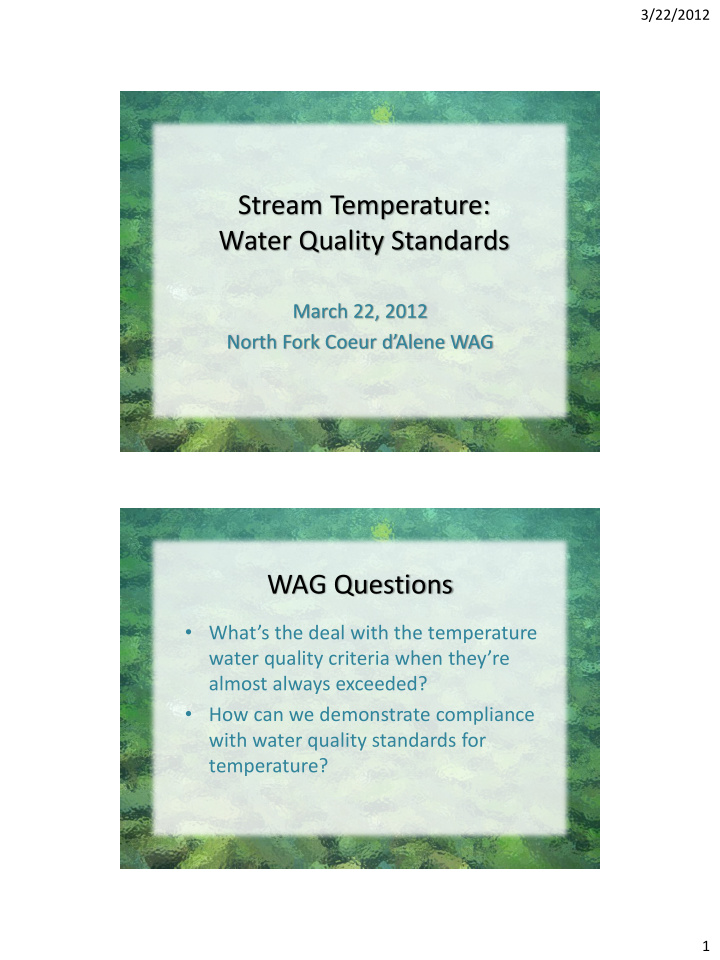



3/22/2012 Stream Temperature: Water Quality Standards March 22, 2012 North Fork Coeur d’Alene WAG WAG Questions • What’s the deal with the temperature water quality criteria when they’re almost always exceeded? • How can we demonstrate compliance with water quality standards for temperature? 1
3/22/2012 Water Quality Criteria - General • Set by DEQ through legislative rulemaking • Based on best available science and information • Must be approved by EPA • EPA also has authority under Clean Water Act to establish criteria Water Quality Criteria - Temperature • DEQ established criteria for temperature to protect aquatic life • EPA also established criteria for temperature to protect bull trout in Idaho • Numeric criteria (see handout) plus natural background provisions 2
3/22/2012 Water Quality Criteria - Temperature • DEQ recognizes rules are difficult to attain • DEQ has conducted research on the topic and attempted to change criteria • DEQ has limited options to adopt other criteria due to EPA’s regional recommended criteria • Difficulty assigning numbers to complex systems, use best available science and tools • Recommend reasonable approach to these issues and focus on implementation Water Quality Criteria - Temperature • There may be no impairment under certain conditions: • Brief, infrequent and small exceedances when biological data show full support • Extremely high air temperatures • Natural background conditions 3
3/22/2012 Natural Background • Exceedance of criteria due to natural conditions is not impairment. • Are temperature exceedances due to natural background conditions for temperature? • Yes, then do not list! • If some exceedance is due to human causes, even though there is a natural component, then must list. Natural Background Natural for temperature can be shown by: • Watershed is entirely W ilderness or R oadless. • Timber harvests or roads occupy <1% of riparian management zones of perennial streams. • Shade and solar load in the watershed is within 10% of its potential (PNV). • Observed/expected (O/E) macroinvertebrate taxa ratio is >0.91 (less than 8% taxa loss). 4
3/22/2012 Natural Background - Resources http://www.deq.idaho.gov/water-quality/surface- water/standards/natural-background-conditions.aspx Natural Background - Resources • 2003 Report “Concepts and Recommendations for Using the Natural Conditions Provisions” • Currently being revised. 5
3/22/2012 Natural Background - PNV Temperature TMDLs use Potential Natural Vegetation (PNV) to set shade targets and solar loads that meet natural background conditions. See PNV Temperature TMDL Procedures Manual by Shumar and de Varona http://www.deq.idaho.gov/media/528731- pnv_temp_tmdl_manual_revised_1009.pdf Meeting Temperature Standards Demonstrate attainment of standards by: • Meeting numeric criteria • Demonstrating natural background conditions • Wilderness and Roadless, minimally disturbed riparian zones, meet solar load targets, good biological data • Multiple lines of evidence helpful, no “cookie cutter” method 6
3/22/2012 The Way Ahead • Cooperate on TMDL implementation planning and projects to improve stream temperatures • Follow recommendations of draft TMDL including protection of cold water refuge areas The Way Ahead • Provide suggestions for waters likely to attain standards and provide data and documentation to support assessment • Graham Creek? • Cataract and West Elk Creeks? • Deer Creek and tribs to Upper NFCDA? • Develop TMDL/implementation monitoring plan to demonstrate progress and attainment 7
Recommend
More recommend